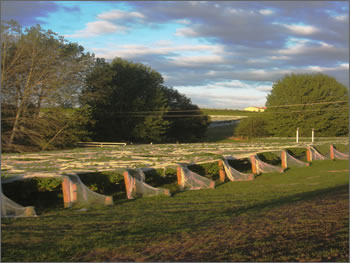Crop Protection

 Bird control isn't just for people in urban areas. Classically, farmers have always had issues with birds, hence the scarecrow. Bird control techniques have dramatically improved since then with advanced bird repellent and protection equipment. Farmers of grapes and other tender fruit can all agree that effective bird control is crucial for a successful harvest. Flocks of birds can have devastating results on an unprepared field of crops. For example, a flock of 5,000 starlings can destroy as much as 1 ton of food in only 10 days. Birds are associated with several tens of millions of dollars of lost crops worldwide every year.
Bird control isn't just for people in urban areas. Classically, farmers have always had issues with birds, hence the scarecrow. Bird control techniques have dramatically improved since then with advanced bird repellent and protection equipment. Farmers of grapes and other tender fruit can all agree that effective bird control is crucial for a successful harvest. Flocks of birds can have devastating results on an unprepared field of crops. For example, a flock of 5,000 starlings can destroy as much as 1 ton of food in only 10 days. Birds are associated with several tens of millions of dollars of lost crops worldwide every year.
First, it is very important to understand the behaviour of birds before you begin to plan you pest control strategy. Second, there are numerous bird repellent techniques to choose from, each with pros and cons for your particular application. Finally, cost and ease of implementation as well as impact on neighbours are weighed to formulate the perfect bird control strategy for your crops.
To effectively defend your crops against birds they must be well understood. Crop damage from birds can be very non-uniform within a particular area and vary dramatically every year. Birds will feed on whatever becomes available; however, they particularly like sweet fruits. Birds that have settled in an area are much more difficult to scare than those that have just arrived. Also, larger flocks are easier to scare away then smaller ones. Birds typically like to feed in the early morning or late evening when the sun is rising or setting. Birds can be very difficult to control as they can become comfortable with repellent methods and even circumvent netting if not properly installed.
Popular bird control technologies include acoustic, visual, physical and chemical repellents. No particular method will be 100% effective on its own; however, combinations of repellents can produce great results.
Acoustical bird repellents include propane-fired cannons (also known as bird bangers), electronic sound devices, and pyrotechnics. These methods can be used to scare birds and by using multiple positioning techniques in conjunction with randomized timings the birds will not be able to adapt to the frightening sounds. Since birds hear just as well as humans, these devices are not always friendly for neighbours.
Visual repellents include scare balloons, flashtape, flashing lights, mirrors, predator silhouettes and falconry. Birds have very sensitive eye sight. Unfortunately, they are not easily startled this way. These repellents are best used to reinforce other repellents.
Physical exclusion normally involves the use of a plastic netting over crops. This can be done by draping the netting over rows of crops or by erecting a structure such that netting covers the entire field. Netting can be costly but can be extremely effective if properly installed and maintained.
Chemical solutions have not see much success in the bird repellent market due to their lack of effectiveness.
Each repellent methodology offers different advantages and disadvantages. No one technology is guaranteed to work in all cases. To choose the best bird repellent to protect your crops, call Nimby Pest Management today.
1-888-681-6266